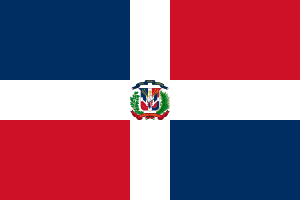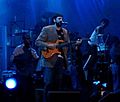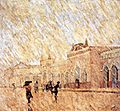Dominican people (Dominican Republic) facts for kids
 |
|
| Total population | |
|---|---|
| Dominican people 13,263,000 Total population of Dominican Republic |
|
| Regions with significant populations | |
| 13,263,000 | |
| 2,000,000 | |
| 120,000 | |
| 100,000 | |
| 88,500 | |
| 63,000 (in scattered places) | |
| 49,000 | |
| 30,000 | |
| 22,000 | |
| Virgin Islands (USA or Britsh) | Unknown |
| Unknown | |
| Unknown | |
| Languages | |
| Spanish | |
| Religion | |
| Roman Catholic; Protestant, Dominican Vudu, Santeria, Other African regligions. | |
| Related ethnic groups | |
| Other Latin Americans (As well as other Caribbean or West Indian peoples). | |
Dominicans (Spanish: Dominicanos) are inhabitants or citizens of the Dominican Republic. The Dominican Republic is a multi-ethnic country in the Caribbean basin which is home to people of many different racial, ethnic, national and cultural backgrounds which has often become a great pride for many Dominicans.
The people and the race
It is estimated that some 894,000 enslaved Africans were brought to Dominican Republic between 1717 and 1870 (and more before 1717). The slaves came from various West African regions, but the majority came from primarily the Congo region (present-day Angola, Congo, Gabon, and Cameroon) and the gold coast/Guinean (present-day Ghana and Guinea).
In addition, many immigrants arrived from other places around the world. After the last smuggled slave ship that arrived in 1898, many Chinese people came to the island due to the Chinese Revolution, along with the Arabs of North Africa (Morocco or Algeria) and Indians. Immigration from Europe, most notably Spaniards, Italians and Germans occurred during the later parts of the nineteenth century into the beginning of the twentieth century, mostly settling in Santo Domingo and in rural areas in the Cibao valley alike. During World War II, the Dominican Republic became the only nation to take in Jewish refugees by orders from then president Rafael Leonidas Trujillo. Nearly 800 German and Austrian Jews settled in the town of Sosua, Puerto Plata.
Today, much of the contemporary Dominican population is largely Mulatto. The Dominican Republic itself is 73% Mulatto, 16% White and 11% Black. Studies have indicated that up to 15% of all Dominicans carry maternal Taino-Arawak lineage, figures which are higher in rural areas. Other studies often indicate that the average Dominican is 53% European (mostly Spanish), 39% Sub-Saharan African and 8% Taino-Arawak, but these figures also vary by region as the Black race is the predominant race in the southern and coastal regions of the country.
Images for kids
-
Map of the Dominican Republic
-
Dominican Republic people in the town of Moca.
-
Iglesia Sagrado Corazón de Jesus in Moca, Dominican Republic.
-
People attending mass in Cathedral of Santo Domingo.
-
Dominican native and Major League Baseball player Albert Pujols
See also
 In Spanish: Dominicanos para niños
In Spanish: Dominicanos para niños

























